Discover the delightful simplicity of cooking with fresh ingredients in this **Sauteed Eggplant Salad Recipe**. Imagine tender, garlicky eggplant mingling with vibrant red peppers and fragrant fresh parsley – a combination so irresistibly delicious, it will have you coming back for more. This incredibly easy **sautéed eggplant recipe** transforms humble vegetables into a culinary masterpiece in just 20 minutes, making it a perfect quick side dish, a light and satisfying lunch, or a fantastic addition to any meal. Its robust flavors and straightforward preparation will quickly earn it a permanent spot in your weekly rotation.

Cooking eggplant on the stovetop with minimal, fresh ingredients is made effortlessly simple with this flavorful **sauteed eggplant recipe**. While sautéing brings out a unique tender texture and caramelized notes, fresh eggplant is incredibly versatile and can also be roasted or grilled. Whether you’re seeking a **healthy eggplant side dish** that everyone will adore or a quick vegetarian option, eggplant delivers. If you find yourself with an abundance of this wonderful nightshade, here are a few more easy eggplant recipes to explore, showcasing its diverse culinary potential:
- Mediterranean Roasted Eggplant: This recipe transforms simple eggplant slices and fresh herbs into a remarkably healthy and flavorful side dish, requiring surprisingly little oil. It’s a fantastic way to enjoy eggplant’s earthy notes.
- Grilled Ratatouille Salad: One of the best ways to utilize an abundance of fresh summer vegetables. Grilling adds a lovely smoky depth without heating up your kitchen, making it perfect for warmer months.
- Baba Ghanoush: A delicious and creamy addition to your summer dip repertoire. This recipe combines sauteed vegetables with a whole roasted eggplant for an unmatched depth of flavor. It’s widely considered one of the best eggplant dips out there. Serve it alongside warm pita bread and crispy falafel balls for a satisfying and complete summer main course.
Why You’ll Adore This Sauteed Eggplant Salad Recipe
This **Sauteed Eggplant Salad** isn’t just another dish; it’s a testament to how simple ingredients, when handled with care, can create extraordinary flavors. Here’s why this recipe will quickly become a favorite:
- Quick and Effortless Preparation: From start to finish, this entire dish comes together in just 20 minutes. It’s ideal for busy weeknights when you crave a homemade, flavorful meal but are short on time. Its speed doesn’t compromise on taste or quality, making it a true kitchen hero.
- Minimal Cleanup with One Pan: Say goodbye to piles of dirty dishes! This recipe primarily utilizes a single pan for cooking, drastically cutting down on post-meal cleanup. Less time scrubbing means more time enjoying your delicious **garlicky eggplant** creation.
- Simple Yet Profoundly Flavorful: The magic of this dish lies in its embrace of natural flavors. Fresh garlic and a hint of cumin are all that’s needed to beautifully enhance the inherent sweetness of the eggplant and bell peppers, along with the bright zest of fresh herbs. It’s a testament to how uncomplicated ingredients can yield complex and satisfying tastes.
- A Wholesome and Healthy Side Dish: Packed with nutrient-rich vegetables and healthy fats from olive oil, this **healthy eggplant side dish** is a guilt-free indulgence. It’s naturally vegetarian and can easily be made vegan, providing a nutritious option that everyone, regardless of dietary preference, is sure to love.
Essential Ingredients and Clever Substitutions
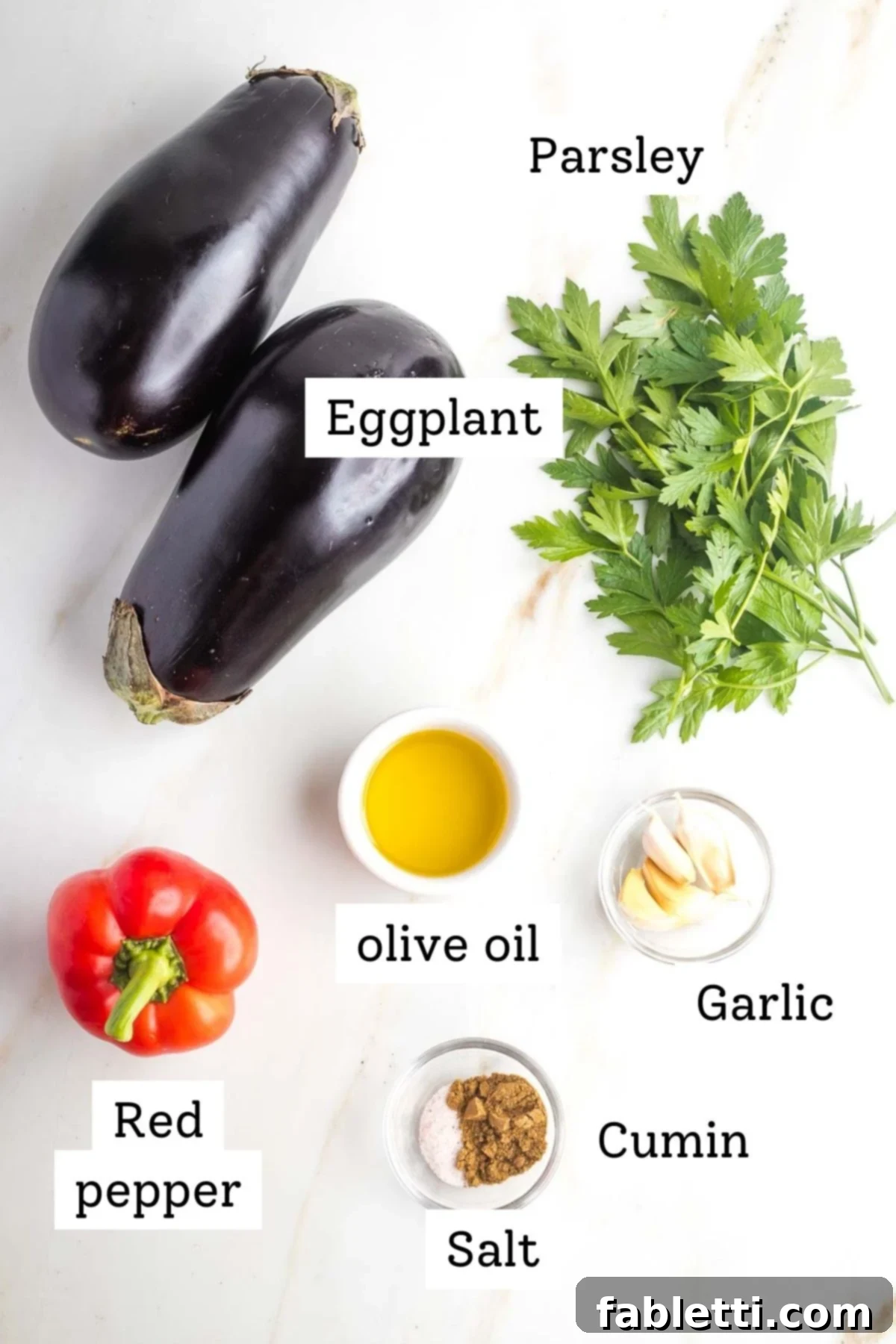
Crafting the perfect **Sauteed Eggplant Salad** starts with understanding each ingredient’s role and knowing how to make smart substitutions. Here’s what you’ll need:
- Eggplant: The star of our show! Look for firm, shiny eggplants without soft spots. While globe eggplants are common, many varieties work beautifully (see section below). For a change of pace, you could also use zucchini or yellow summer squash; just note they will cook much faster, typically in about half the time.
- Fresh Parsley: I advocate for generous amounts of fresh herbs in this dish, as they provide a vibrant freshness that truly elevates the flavor profile. If parsley isn’t your preference or isn’t available, feel free to substitute with other fresh herbs like oregano, basil, or thyme. The more, the merrier!
- Red Bell Pepper: Bell peppers are wonderfully in season at the same time as fresh eggplant, making them a natural pairing. Their sweetness and slight crunch offer a delightful contrast to the tender eggplant. Any color of bell pepper will work, so use what you have on hand – green, yellow, or orange will add similar texture and flavor.
- Garlic: Fresh garlic is non-negotiable for the most robust and aromatic flavor in this **garlicky eggplant** dish. Its pungent notes mellow beautifully when cooked, infusing the entire salad. In a pinch, you can use garlic powder, but be sure to avoid garlic salt, as it will throw off the seasoning balance.
- Olive Oil: Extra virgin olive oil provides a rich, fruity base for sautéing. Remember, eggplant is like a sponge and will readily soak up oil. It’s crucial to drizzle it in phases, a bit at a time, to prevent the dish from becoming overly greasy while ensuring the eggplant cooks evenly without sticking.
- Spices (Cumin and Salt): Cumin is the secret weapon here, imparting a lovely, subtle smoky and earthy flavor that complements the eggplant wonderfully. A touch of coarse sea salt is essential to intensify all the fresh flavors and bring out the best in the vegetables.
Exploring the World of Eggplant Varieties for Your Salad
The beauty of this **Sauteed Eggplant Salad** is its adaptability to various types of eggplant. You can often find an exciting array of these beautiful vegetables at your local farmers’ markets, specialty ethnic grocery stores, or even in the “locally grown” section of your favorite supermarket. Any of the eggplant varieties listed below will work wonderfully in this recipe, each bringing its own subtle characteristics:
- Asian Eggplants: This category encompasses several similar yet distinct types of eggplant, all known for their delicate flavor and texture.
- Japanese Eggplant: Characterized by its long, thin shape and deep purple skin. These eggplants have a thinner outer skin and generally cook much more quickly than their larger counterparts. If you choose Japanese eggplant, be prepared to reduce the cooking time by approximately half.
- Chinese Eggplant: Typically slender, long, and sporting a medium-hued purple skin with creamy white flesh. Chinese eggplants tend to have fewer seeds, which results in a less bitter taste compared to the American globe eggplant. This makes them exceptionally well-suited for stir-fried dishes or this particular **sauteed eggplant recipe**. Like Japanese varieties, they will also take less time to cook.
- Italian Eggplants: These are quite similar in appearance and texture to the American Globe Eggplant, but they are generally smaller and possess a more tender flesh. Their manageable size makes them easy to cube evenly for quick cooking.
- White Eggplant: Often considered the “original” eggplant, many of today’s white eggplants are heirloom varieties. While their exterior skin is distinctly white, the inside looks just like traditional purple-skinned eggplants. They can be used interchangeably in all the same recipes, offering a unique aesthetic to your dish.
- Globe Eggplants: Also widely known as American eggplants, these are the most common variety found in Western supermarkets. They are large, plump, and characterized by their ability to hold their shape well during cooking, offering a satisfyingly meatier texture. Globe eggplants are excellent for roasting in slices, deep frying, making air fryer eggplant dishes, and, of course, for sautéing until they achieve a wonderfully soft and tender consistency.
Mastering the Art of Cubing Eggplant
Properly cutting your eggplant is key to ensuring even cooking and a consistent texture in your **Sauteed Eggplant Salad**. Follow these simple steps to achieve perfect ½-inch cubes:
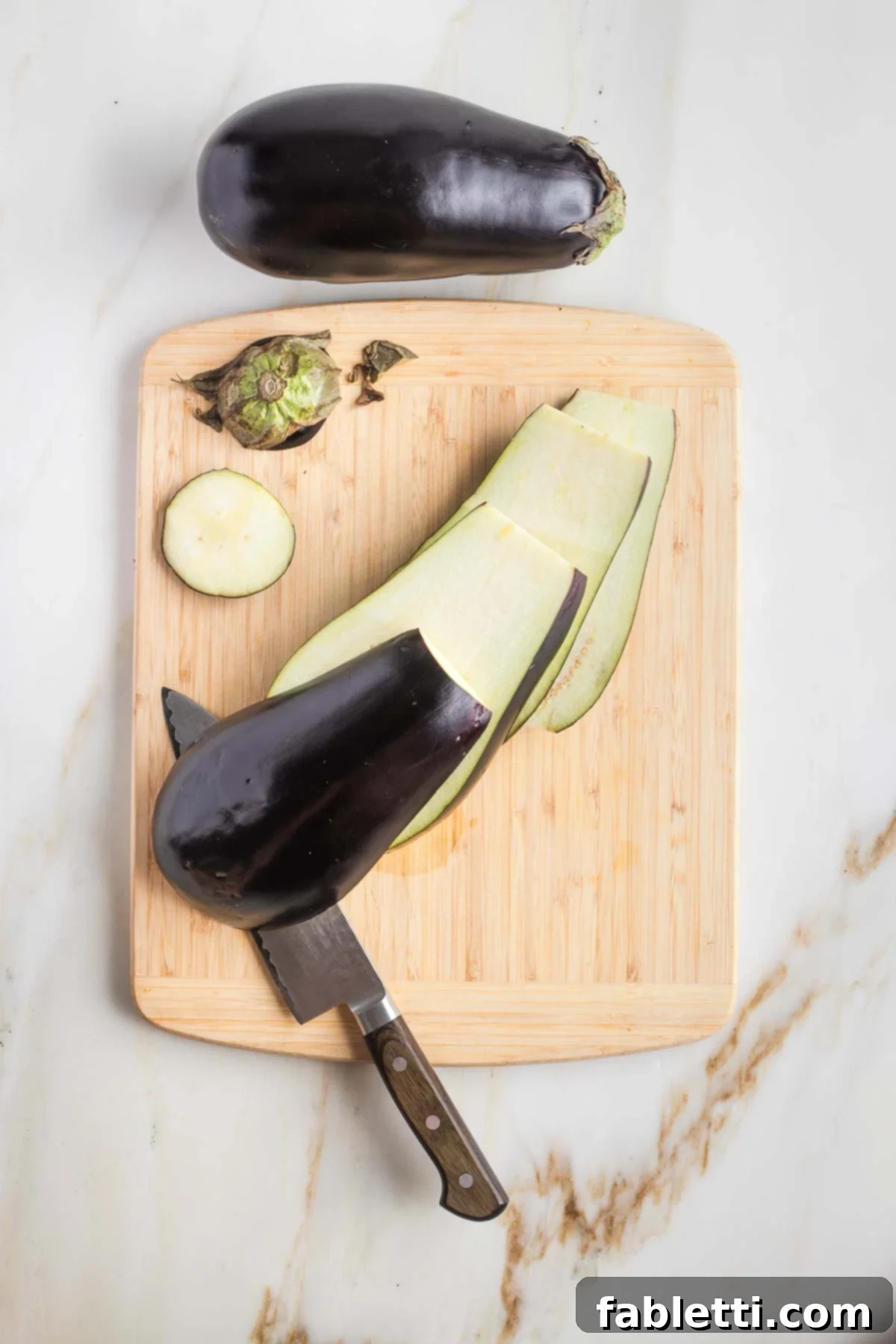
Begin by cutting off both the stem end (top) and the bottom end (tail) of the eggplant. This provides a stable base. Place the eggplant cut-side down on your cutting board, then make ½-inch vertical cuts all the way through, creating thick slices.
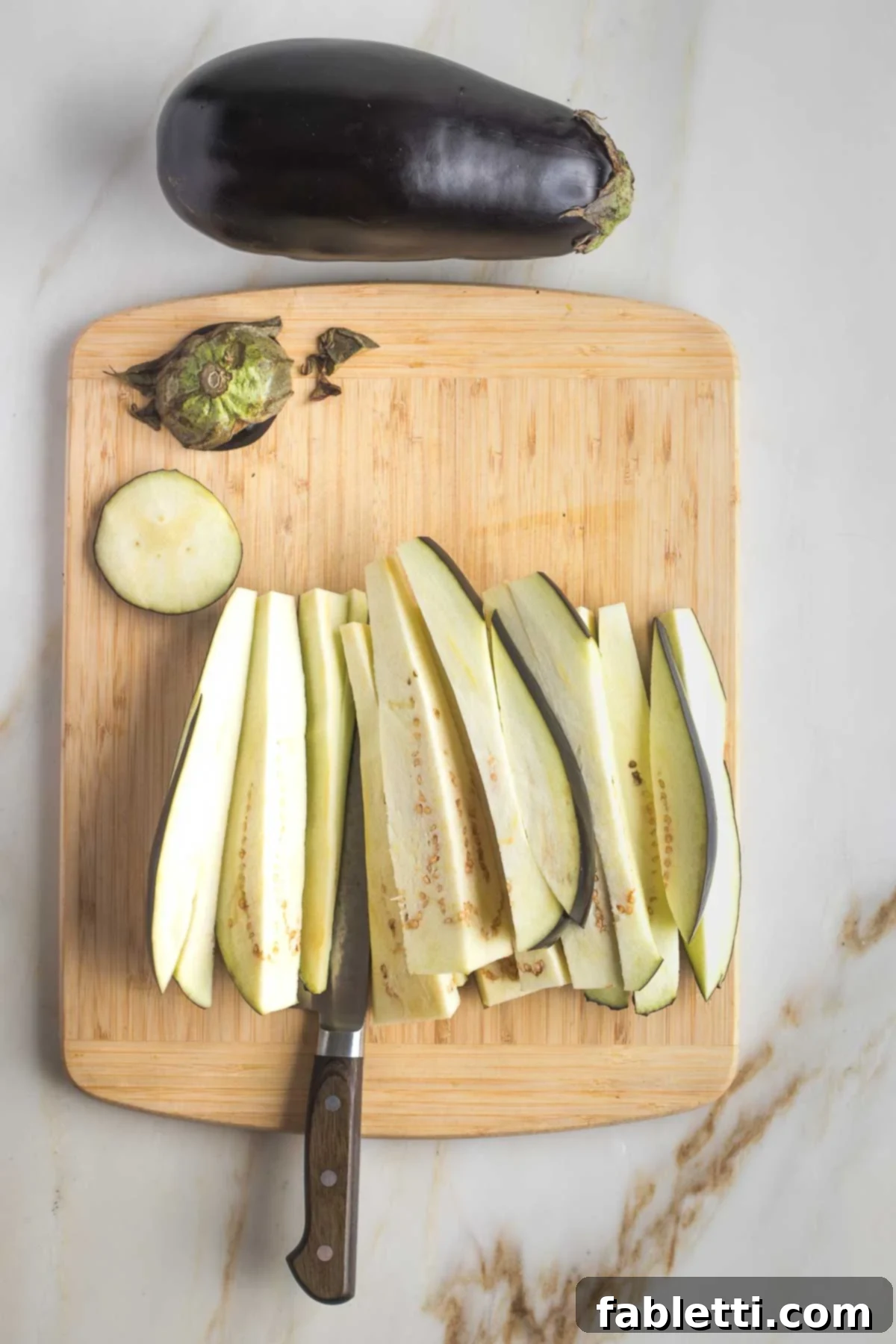
Once you have your ½-inch thick slices, lay them flat on the cutting board. Now, cut these slices into long, vertical strips, also ½-inch thick. This forms uniform “sticks” of eggplant.

Finally, take your ½-inch thick strips and cut across them, again at ½-inch intervals, to form perfectly uniform cubes. The goal is to have all pieces roughly the same size to ensure they cook evenly.
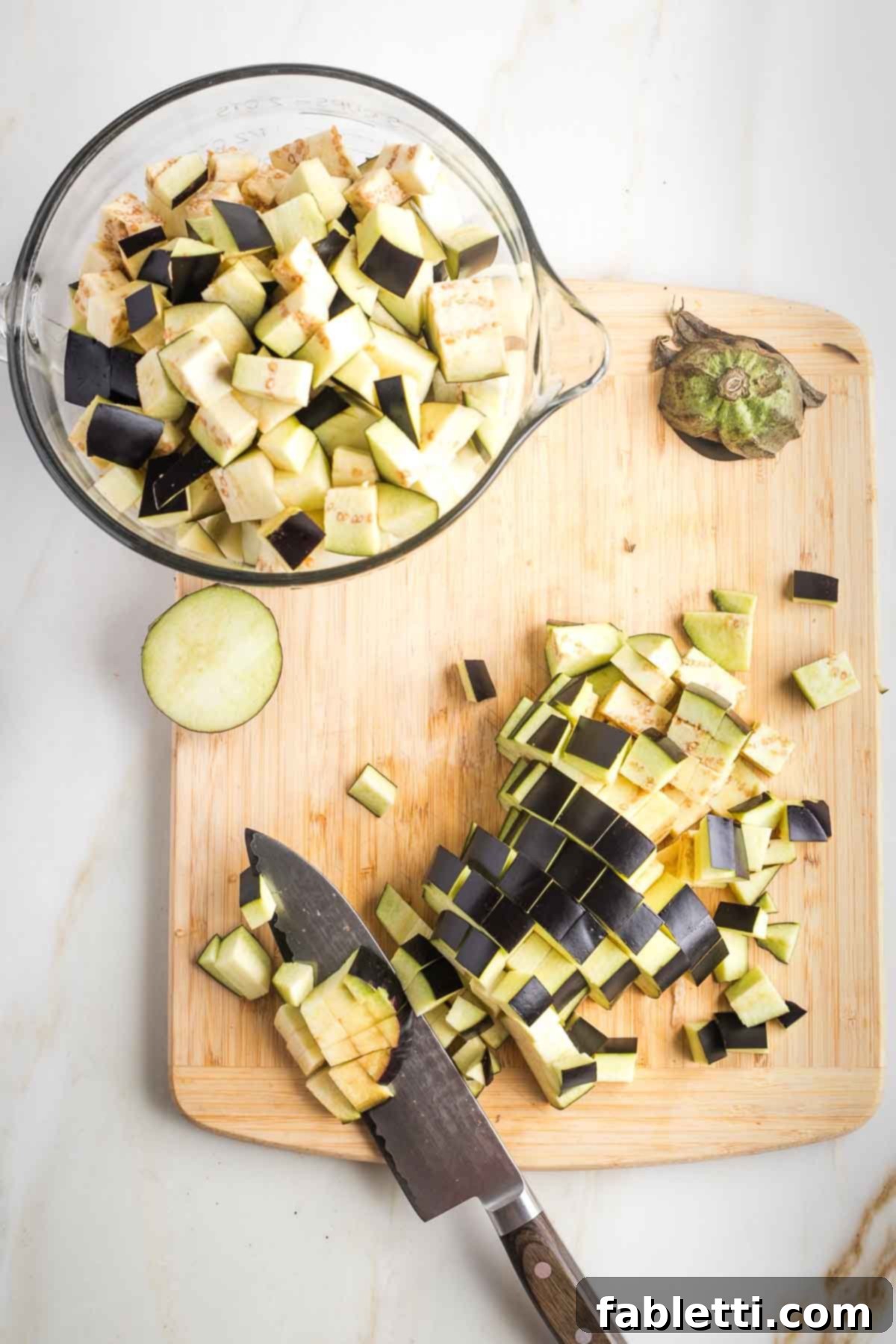
Repeat this cubing process with your second eggplant. From two medium-large eggplants, you should yield approximately 8 cups of beautifully cubed eggplant, ready for sautéing. This precise preparation is crucial for the optimal texture of your **Sauteed Eggplant Salad**.
Crafting Your Flavorful Eggplant Salad: Preparation Steps
This **sauteed eggplant salad** comes together quickly on the stovetop, making efficient preparation key. To ensure a smooth and enjoyable cooking experience, it’s always best to prep all your vegetables before you even begin heating your pan. This practice, known as mise en place, streamlines the cooking process and prevents frantic rushing.

Start by separating the delicate parsley leaves from their tougher stems. Once separated, roughly chop the leaves to your desired fineness – I prefer a fine chop for even distribution throughout the salad. Set the chopped parsley aside; we’ll use it in two stages for maximum freshness.

Next, prepare your garlic. Place each garlic clove on your cutting board and use the flat side of a chef’s knife to firmly smash it. This helps loosen the papery skins, making them easier to peel off. Once peeled, roughly chop the garlic. Like the parsley, set the prepped garlic aside, as it will be added later to preserve its aromatic punch.
The Art of Sautéing Eggplant to Perfection
Sautéing eggplant correctly is crucial for its texture and flavor. Eggplant is notorious for acting like a sponge, eagerly soaking up any liquid it encounters, especially oil. This characteristic is precisely why I recommend drizzling on the olive oil in carefully timed phases. This technique helps to prevent sticking, ensures even cooking, and allows the eggplant to brown beautifully without becoming excessively oily. Using a well-seasoned cast iron skillet is also a fantastic advantage here, as its even heat distribution and natural non-stick properties contribute significantly to a superior result.

Begin by placing your cast iron or another heavy-bottomed skillet over medium-high heat. Allow it to heat thoroughly for a minute or two. Then, swirl in 2 tablespoons of the extra virgin olive oil. Once the oil shimmers, add the cubed eggplant. Toss the eggplant to coat, then continue to cook, stirring frequently, for about 3-4 minutes. At this stage, the pan may seem very full, but don’t worry – the eggplant will shrink considerably as it cooks down.
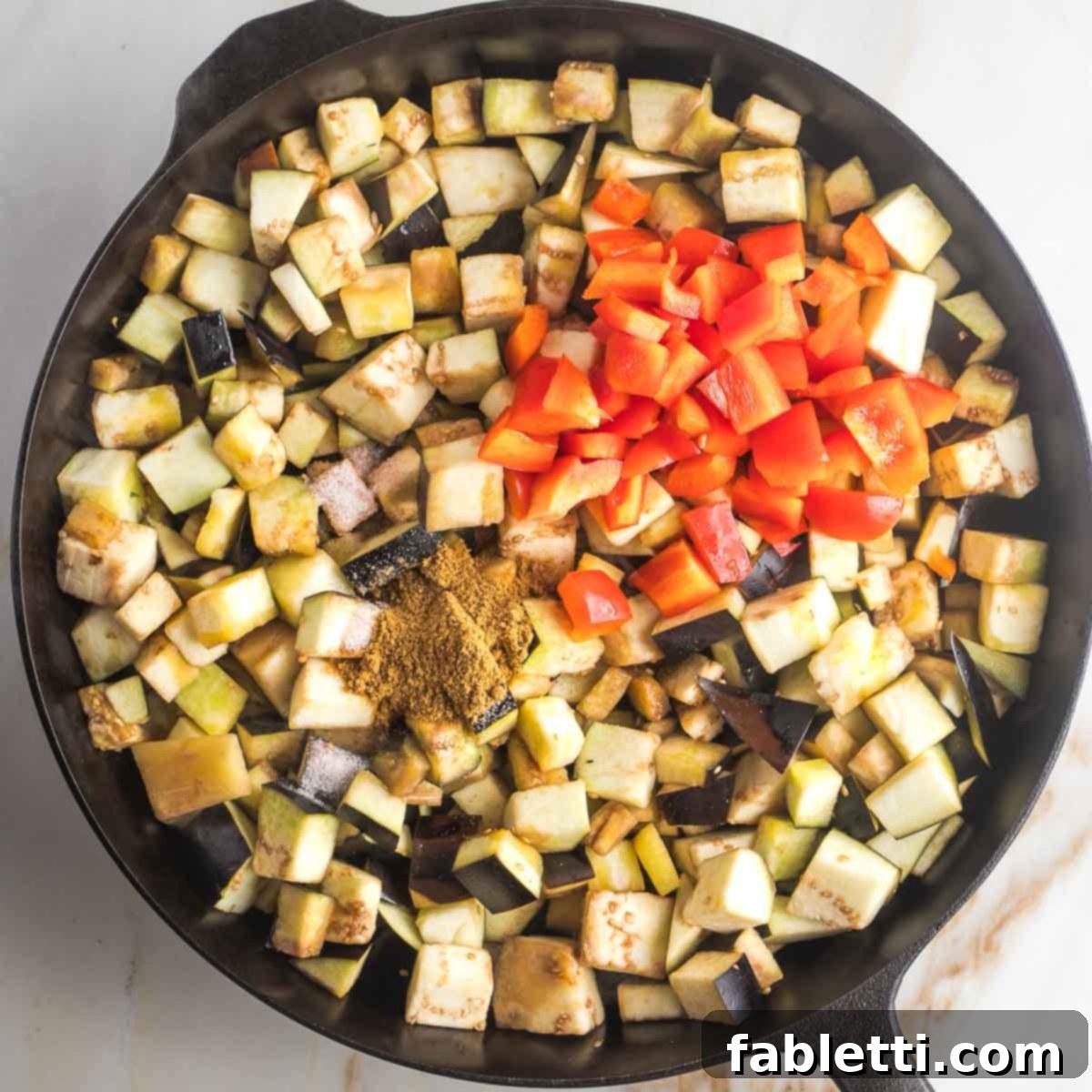
Next, add the diced red peppers, the aromatic cumin, and a pinch of salt to the skillet. Drizzle in the final tablespoon of olive oil. Stir all the ingredients together thoroughly, ensuring everything is well combined and evenly distributed. Continue to cook, stirring frequently, until the eggplant becomes beautifully tender and the peppers soften. This usually takes an additional 6-8 minutes. As it cooks, the entire mixture will visibly shrink, concentrating its flavors to about one-third of its original volume.
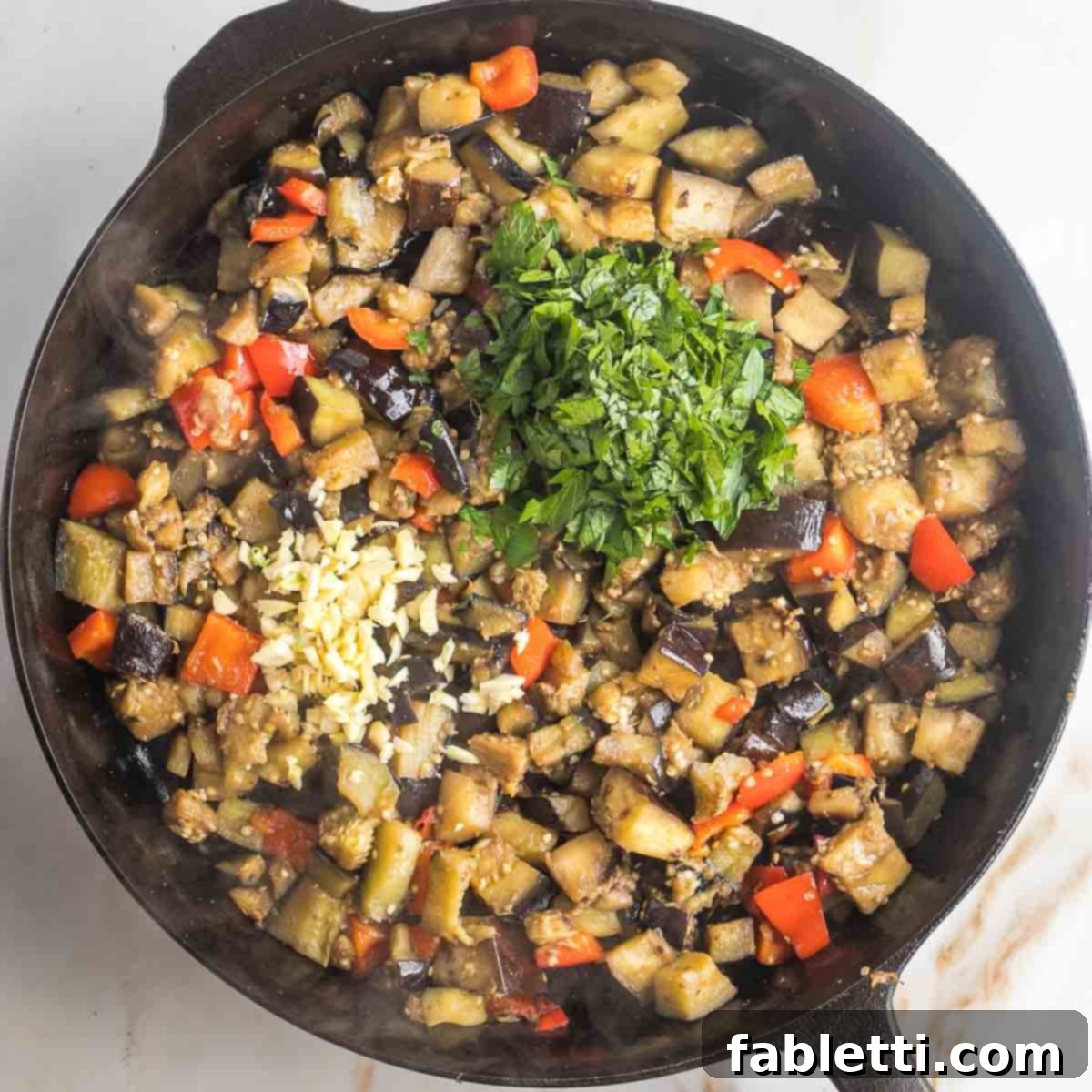
Once the eggplant is tender, sprinkle on ¼ cup of your freshly chopped parsley and all of the minced garlic. Stir well to incorporate these aromatics evenly throughout the dish. Continue to cook for another 2-3 minutes, stirring constantly, until the garlic becomes wonderfully fragrant. Give the mixture one final stir to ensure any larger pieces of eggplant are completely tender, indicating it’s perfectly cooked.

Turn off the heat. Now, sprinkle in the remaining ¼ cup of fresh parsley. This last addition of parsley provides a burst of fresh flavor and color, preventing it from overcooking. Mix everything well. Transfer your vibrant **Sauteed Eggplant Salad** to a beautiful serving dish. It’s absolutely delicious served warm, allowing the flavors to truly shine, but it’s equally delightful enjoyed at room temperature, making it a versatile option for any occasion.
Creative Culinary Twists: Elevating Your Eggplant Salad
Honestly, this **Sauteed Eggplant Salad** is absolute perfection as is – a harmonious blend of flavors and textures that truly shines. But for those moments when you’re feeling a bit adventurous and want to put your own unique spin on it, don’t hesitate to embellish! Here are some fantastic variations to explore, transforming this already stellar dish:
- Mediterranean Infusion: My personal favorite way to add an extra layer of complexity is by incorporating chopped olives (Kalamata or Castelvetrano work beautifully) and/or briny capers. These ingredients introduce a wonderful salty, tangy dimension that gives off an unmistakable **Mediterranean Eggplant Salad** vibe. My husband isn’t a fan, so I often enjoy this variation when cooking for myself, but it’s truly amazing!
- Nuts and Seeds for Crunch and Protein: Adding any form of nuts or seeds will introduce a delightful textural contrast and a boost of protein. Toasted pine nuts and chopped almonds are my top choices, lending a subtle richness. Sesame seeds also work great, though they tend to impart more of an Asian flavor profile, which can be a fun twist!
- A Bright Touch of Acid: A touch of acidity can wonderfully balance the richness of the cooked eggplant. Freshly chopped tomatoes, particularly cherry tomatoes cut in half, add a burst of juicy sweetness and a gentle tang. Alternatively, you can achieve that perfect acidic balance with a quick splash of high-quality balsamic vinegar or a squeeze of fresh lemon juice just before serving.
- Spice It Up: For those who love a bit of heat, transform this into a **Spicy Sauteed Eggplant** dish. The best way to introduce a pleasant kick is to sprinkle in a pinch or two of red pepper flakes at the same time you add the cumin. This allows the heat to infuse evenly throughout the vegetables as they cook.
Creative Ways to Serve This Versatile Eggplant Dish
The beauty of this **Sauteed Eggplant Salad** lies in its incredible versatility. It adapts effortlessly to various roles at your table, making it a truly flexible and indispensable recipe:
- As a Refreshing Salad: Serve it chilled or at room temperature as a vibrant standalone salad. Its fresh flavors make it a perfect light lunch or a refreshing appetizer on a warm day.
- As a Complementary Side Dish: This eggplant dish shines as a warm or room-temperature side. Its garlicky, savory profile pairs wonderfully with a variety of main courses. Consider serving it alongside tofu satay, baked falafel, grilled chicken, pan-seared fish, or even a hearty grain bowl for a balanced and flavorful meal.
- As a Delectable Dip or Spread: Don’t limit this dish to just a salad or side! Its tender texture and rich flavors make it an excellent dip or spread. Spoon generous amounts onto a quick and easy flatbread for a simple meal, or slather spoonfuls onto slices of crusty bread and serve as an elegant eggplant bruschetta. It also makes a fantastic addition to a crudités board, accompanied by an assortment of crackers and fresh vegetables for dipping.
Storage and Reheating Tips for Leftovers
One of the best things about this **Sauteed Eggplant Salad** is how well it keeps, making it perfect for meal prep or enjoying leftovers. Proper storage ensures its delicious flavors and textures remain intact:
- Refrigeration: Any leftover **sauteed eggplant** can be stored in an airtight container in the refrigerator for up to 5 days. This allows the flavors to meld even further, often tasting even better the next day!
- Reheating: If you prefer to enjoy it warm, you can gently reheat leftovers in a 300-degree Fahrenheit oven for about 10 minutes, or on the stovetop over medium-low heat until just heated through. Be careful not to overcook, as this can make the eggplant mushy.
- Enjoy Cold or Room Temperature: The beauty of this dish is its versatility. Leftovers are absolutely delicious eaten cold straight from the fridge or allowed to come to room temperature, offering a refreshing and convenient meal option.
- Freezing: Freezing is generally not recommended for this dish. The high water content in eggplant means that upon thawing, its texture will become mushy and unappetizing. It’s best to enjoy this **fresh eggplant recipe** within the suggested refrigeration period.
Debra’s Pro Tips for the Best Sauteed Eggplant Salad

Achieving a perfectly tender and flavorful **Sauteed Eggplant Salad** is easy with these insider tips:
- Adjust for Eggplant Size: This recipe is designed for two medium-large eggplants, yielding roughly 8 cups of cubed eggplant. If your eggplants are significantly larger and produce more than 8 cups, you’ll need to incrementally increase the amounts of olive oil, cumin, and salt. Adjust to taste, adding a little at a time to maintain balance.
- Choose the Right Pan Size: Always use your largest frying pan or skillet when sautéing eggplant. While the eggplant will shrink considerably as it cooks, it starts out quite voluminous. An overcrowded pan will steam the eggplant rather than sauté it, preventing it from browning nicely and developing that desirable tender texture.
- Resist Adding Water: If your pan appears dry during cooking, resist the temptation to add water. Eggplant will quickly absorb it and turn rubbery, losing its pleasant texture. Instead, follow the phased oil addition method outlined in the instructions and stir frequently. This technique, combined with a good heavy-bottomed pan, is your best defense against sticking and ensures the eggplant cubes cook beautifully and develop a rich, caramelized exterior.
Your engagement means the world to food bloggers! If you’ve enjoyed this **Sauteed Eggplant Salad Recipe**, please consider leaving a five-star rating and a comment below to share your experience. We love seeing your creations, so please tag me @dkhealthcoach and use the hashtag #debraklein on Instagram to share your photos!
📖 Recipe
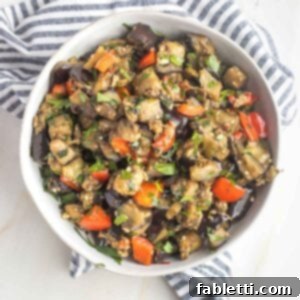
Sauteed Eggplant Salad
Debra Klein
Rate this Recipe
Pin Recipe
5
15
20
Salad, Side Dish
American, Mediterranean
4
170 kcal
Equipment
- Cast iron skillet
- Chef’s knife
- Extra Large Bamboo Cutting Board
- Spatula
Ingredients
Servings: 4
- 2 medium-large eggplants about 8 cups cubed
- 1 red bell pepper
- 3 tablespoon extra virgin olive oil
- 1 ½ teaspoon cumin
- ½ teaspoon coarse sea salt
- 3 cloves garlic
- ½ cup fresh parsley finely chopped and divided
Instructions
- Finely chop parsley. Smash garlic cloves and then roughly chop. Set aside prepped garlic and parsley.
- Cut off the stem end and bottom of the eggplant. Set flat on a cutting board on the bottom cut side. Make ½-inch slices through the top. Lay them flat and cut into ½-inch strips and then across to make ½-inch cubes.
- Set a heavy skillet over medium-high heat and swirl in 1 tablespoon of the olive oil. Toss in the eggplant cubes, then drizzle on another 1 tablespoon oil. Cook for 3-4 minutes, stirring a couple of times. The pan will seem super full. It’s perfectly fine and temporary, as the eggplant will shrink considerably as it cooks.
- Meanwhile, dice the red pepper. Add it to the pan with the eggplant along with cumin and salt, and drizzle the remaining tablespoon of olive oil into the pan.
- Continue to cook, stirring frequently to prevent the eggplant from sticking to the bottom. Use a heavy spatula to scrape any bits off as you cook.
- When the eggplant is tender (about 6-8 minutes), sprinkle on ¼ cup of the parsley and all of the garlic. Stir and cook for about 2 minutes, until the garlic is fragrant.
- Turn off the heat and stir in the remaining ¼ cup of parsley. Taste for seasoning and add a pinch of red pepper flakes if desired for a touch of heat. Transfer to a serving dish and enjoy warm or at room temperature.
Notes
Nutrition
Calories:
170
kcal
Carbohydrates:
16
g
Protein:
3
g
Fat:
12
g
Saturated Fat:
2
g
Polyunsaturated Fat:
1
g
Monounsaturated Fat:
8
g
Sodium:
302
mg
Potassium:
642
mg
Fiber:
8
g
Sugar:
9
g
Vitamin A:
1625
IU
Vitamin C:
53
mg
Calcium:
40
mg
Iron:
2
mg
Note
The nutrition calculations were done using online tools. To obtain the most accurate representation of the nutritional information in any given recipe, you should calculate the nutritional information with the actual ingredients you used. You are ultimately responsible for ensuring that any nutritional information is accurate, complete and useful.
